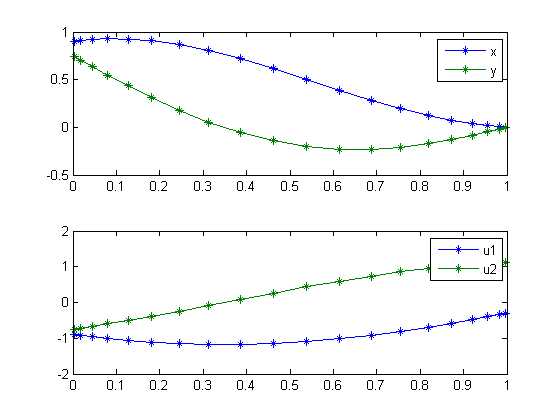Rigid Body Rotation
On smooth optimal control determination, Ilya Ioslovich and Per-Olof Gutman, Technion, Israel Institute of Technology.
Example 1: Rigid body rotation
Contents
Problem Description
Find u over t in [0; 1 ] to minimize:

subject to:




![$$ x(t_0) = [0.9 \ 0.75] $$](xrigidBodyRotation_eq70619.png)
![$$ x(t_f) = [0 \ 0] $$](xrigidBodyRotation_eq66077.png)

% Copyright (c) 2007-2008 by Tomlab Optimization Inc.
Problem setup
toms t p = tomPhase('p', t, 0, 1, 20); setPhase(p); tomStates x y u1 u2 % Boundary constraints cbnd = {initial({x == 0.9; y == 0.75}) final({x == 0; y == 0})}; % ODEs and path constraints a = 2; ceq = collocate({dot(x) == a*y+u1; dot(y) == -a*x+u2 dot(u1) == a*u2; dot(u2) == -a*u1}); % Objective objective = 0.25*integrate((u1.^2+u2.^2).^2);
Solve the problem
options = struct;
options.name = 'Rigid Body Rotation';
solution = ezsolve(objective, {cbnd, ceq}, [], options);
t = subs(collocate(t),solution);
x = subs(collocate(x),solution);
y = subs(collocate(y),solution);
u1 = subs(collocate(u1),solution);
u2 = subs(collocate(u2),solution);
Problem type appears to be: con
===== * * * =================================================================== * * *
TOMLAB - Tomlab Optimization Inc. Development license 999001. Valid to 2010-02-05
=====================================================================================
Problem: --- 1: Rigid Body Rotation f_k 0.470939062499997170
sum(|constr|) 0.000000000000549555
f(x_k) + sum(|constr|) 0.470939062500546730
f(x_0) 0.000000000000000000
Solver: snopt. EXIT=0. INFORM=1.
SNOPT 7.2-5 NLP code
Optimality conditions satisfied
FuncEv 3 GradEv 1 MinorIter 34
CPU time: 0.015625 sec. Elapsed time: 0.016000 sec.
Plot result
figure(1); subplot(2,1,1); plot(t,x,'*-',t,y,'*-'); legend('x','y'); subplot(2,1,2); plot(t,u1,'*-',t,u2,'*-'); legend('u1','u2');
